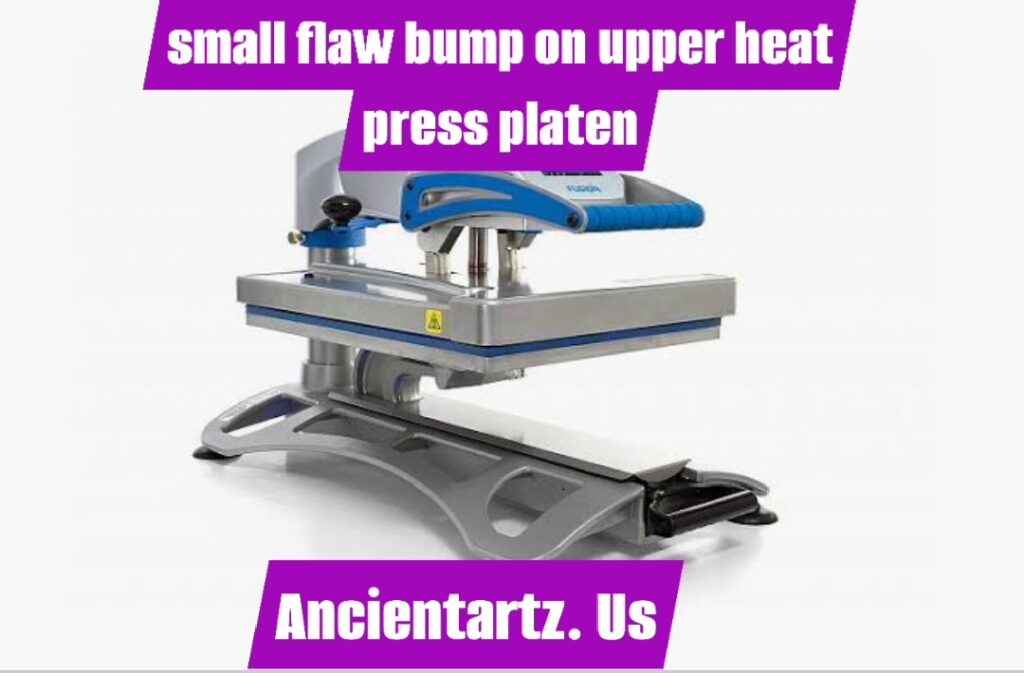Introduction
A heat press machine is an essential tool in the garment printing industry, widely used for transferring designs onto fabrics, ceramics, and other materials. It operates by applying heat and pressure to ensure the design adheres properly to the surface. However, even the most advanced heat press machines can develop issues that affect the quality of their output. One of the most common yet often overlooked defects is a small flaw or bump on the upper heat press platen . While it may seem insignificant at first, this seemingly minor defect can have far-reaching consequences on the final product.
Understanding the impact of a small bump on the upper platen is crucial for any business or individual who relies on heat press machines for production. The platen plays a critical role in ensuring even pressure distribution, and any deformity can result in inconsistent heat application. This inconsistency can lead to defects such as incomplete transfers, faded prints, or even damage to the substrate. Moreover, such flaws can significantly reduce the efficiency of production, leading to increased waste, higher costs, and dissatisfied customers.
In this comprehensive article, we will delve deep into the implications of a small flaw on the upper heat press platen, analyzing how it affects performance, causes production issues, and impacts business operations. We will also discuss the potential solutions, maintenance strategies, and ways to prevent such defects from occurring in the first place. By understanding the complexities associated with this issue, heat press users can ensure they maintain the highest quality standards in their printing processes.
Effects of a Small Flaw or Bump on the Upper Heat Press Platen
Uneven Pressure Distribution and Its Impact on Print Quality
One of the most immediate and noticeable effects of a bump on the upper platen is the disruption of even pressure distribution. A heat press machine relies on uniform pressure to transfer designs effectively onto the substrate. Any irregularity, such as a small bump, can cause certain areas of the platen to exert more pressure while other areas may experience less force.
This uneven pressure can result in poor-quality transfers. Areas receiving excessive pressure might cause ink bleeding or excessive compression of the substrate, while areas with insufficient pressure may result in incomplete transfers, ghosting effects, or fading. This inconsistency can be highly detrimental, particularly when working on bulk orders, where quality control is crucial. Customers expect uniform prints, and even minor defects can render an entire batch unusable, leading to material wastage and financial loss.
Inconsistent Heat Distribution Leading to Transfer Failures
Heat is a fundamental factor in the heat press process, as it ensures the proper adhesion of transfer materials to the substrate. A small flaw or bump on the platen can create variations in temperature distribution, preventing the heat from being evenly transferred across the design. This irregular heating can cause several issues, including incomplete curing of ink, patchy prints, or peeling of the design after a few washes.
For businesses that prioritize durability and longevity of their prints, a flawed heat distribution can lead to serious customer dissatisfaction. Additionally, if the heat does not reach the required temperature in certain areas, there is a risk that the design will not bond properly with the substrate, leading to defects that require rework or replacement. This not only wastes time but also increases operational costs and reduces efficiency in production.
Potential Damage to the Substrate and Increased Rejection Rates
A heat press machine applies significant pressure and heat to achieve the perfect transfer. When a bump or flaw exists on the upper platen, it can cause stress points on the material being printed. This excess pressure in certain areas can damage delicate fabrics, create indentations, or even scorch the material. This issue is particularly problematic when working with heat-sensitive fabrics such as polyester, which can discolor or melt under uneven pressure.
The increased rejection rates due to defects caused by platen irregularities can be frustrating for businesses. Not only does this result in financial losses, but it also negatively impacts the brand’s reputation. Customers expect high-quality prints, and repeated complaints about defects can lead to loss of trust and reduced sales. Addressing the root cause by ensuring a smooth, flawless platen surface is critical to maintaining a consistent and high-quality output.
Difficulties in Aligning Transfers and Increased Production Time
Precision and efficiency are key in the heat press industry. A small flaw or bump on the upper heat press platen can create alignment issues, causing prints to shift slightly during the pressing process. This misalignment can lead to off-center designs, double images, or distorted prints, which make the final product look unprofessional.
Additionally, operators may need to make adjustments manually to compensate for the flaw, which slows down production. Increased setup time, additional rework, and wasted materials all contribute to inefficiencies that can hinder business growth. In high-volume production settings, even minor delays can result in significant losses over time. Ensuring that the platen surface remains smooth and defect-free is essential for streamlined operations and optimal productivity.
Long-Term Effects on the Heat Press Machine’s Lifespan
A heat press machine is a significant investment, and proper maintenance is key to extending its lifespan. A small bump on the upper platen, if left unaddressed, can contribute to wear and tear on the machine. Over time, the added stress on certain areas may lead to component failure, reduced performance, and costly repairs.
Continuous operation with an uneven platen can also impact the lower platen and other components of the machine. The increased pressure and uneven heat distribution may cause warping or degradation of essential parts, leading to a shortened lifespan of the equipment. Regular inspections and prompt corrective measures can help prevent long-term damage and ensure smooth functioning of the machine.
Conclusion
While a small flaw or bump on the upper heat press platen may appear trivial, its impact on production, quality, and overall efficiency can be significant. From inconsistent pressure and heat distribution to increased rejection rates and misalignment issues, such imperfections can lead to a range of problems that affect both business operations and customer satisfaction.
Taking proactive measures to maintain a smooth platen surface is essential. Regular inspections, proper cleaning, and timely repairs can help prevent such defects from occurring. In cases where the platen is damaged beyond repair, investing in a high-quality replacement is crucial to maintaining consistent and professional-grade results.
For businesses relying on heat press machines for their production, understanding and addressing platen flaws is a fundamental step in ensuring long-term success. By prioritizing equipment maintenance and quality control, operators can minimize losses, improve efficiency, and maintain a strong reputation in the industry. A well-maintained heat press machine translates to high-quality prints, satisfied customers, and a profitable business.
Frequently Asked Questions (FAQs)
1. Can a small bump on the upper platen be fixed, or should the platen be replaced?
In some cases, minor imperfections can be smoothed out using sandpaper or heat-resistant fillers. However, if the bump significantly affects pressure and heat distribution, replacing the platen may be the best solution.
2. How can I prevent my heat press platen from developing flaws?
Regular maintenance, proper cleaning, and avoiding excessive force on the platen can help prevent defects. Using protective sheets and ensuring even pressure distribution during operation can also minimize wear and tear.
3. Will a small flaw on the platen always affect print quality?
Even minor imperfections can cause inconsistencies in transfers, though the severity depends on the size and location of the flaw. It is always best to address any platen defects promptly to ensure uniform prints.
4. Can a heat press platen be resurfaced?
In some cases, resurfacing may be possible through professional refinishing services. However, if the platen is significantly damaged, a replacement may be more cost-effective.
5. What are the signs that my platen needs to be replaced?
Signs include uneven pressure distribution, visible deformities, repeated transfer failures, or excessive wear on certain areas of the platen. If these issues persist despite maintenance efforts, replacement is recommended.
Also Read This: The Impact of a Small Flaw: Bump on Upper Heat Press Platen and Its Consequences


